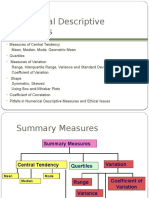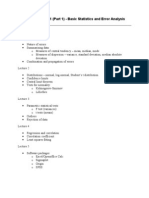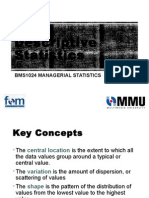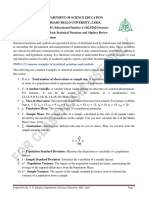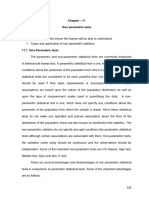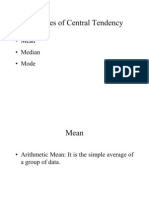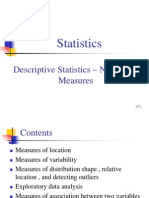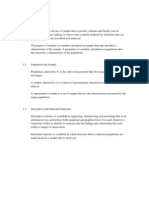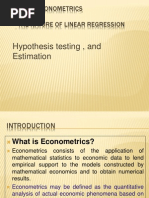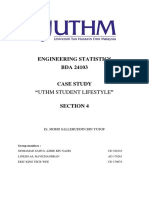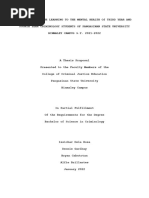ECON1203/ECON2292 Business and Economic Statistics: Week 2
ECON1203/ECON2292 Business and Economic Statistics: Week 2
Uploaded by
Jason PanCopyright:
Available Formats
ECON1203/ECON2292 Business and Economic Statistics: Week 2
ECON1203/ECON2292 Business and Economic Statistics: Week 2
Uploaded by
Jason PanOriginal Title
Copyright
Available Formats
Share this document
Did you find this document useful?
Is this content inappropriate?
Copyright:
Available Formats
ECON1203/ECON2292 Business and Economic Statistics: Week 2
ECON1203/ECON2292 Business and Economic Statistics: Week 2
Uploaded by
Jason PanCopyright:
Available Formats
1
ECON1203/ECON2292
Business and Economic
Statistics
Week 2
Week 2 topics
Measures of central tendency or location
Measures of dispersion or spread
Measures of association
2
Introduction to linear regression
Key references
Keller Chapter 4, especially 4.1-4.4
Numerical summaries of key
features
Previously used graphical methods to
summarize data
Can also use numerical summaries of sample or
populationdata
3
population data
Key features of a single variable
Location, spread, relative standing, skewness
Key feature of two variables
Measures of (linear) association
2
Measures of location
A parameter describes
key feature of a
population
A statistic describes key
f t f l N
x
N
i
i
=
=
1
mean Population
feature of a sample
A natural measure of
location is the arithmetic
mean
Other variants
Weighted mean (WAM)
Geometric mean
n
x
x
N
n
i
i
=
=
1
mean Sample
4
Measures of location
Median is middle value
of ordered observations
When n is odd median
will be unique
5 7
3 4
1
1 ; 3 3 1 0 0
ns observatio 5 of Sample
+
=
>
=
a
Median
a a
n
5
When n is even average
middle two values
Median depends on
ranks of observations
Doubling largest
observation will not
change median
5 7
5
3
> =
a
x
Measures of location
Mode is most frequently occurring value(s)
Modal class previously defined in context of unimodal
histograms
Mean, median & mode all provide different notions
6
of representative or typical central values
For quantitative data mode usually not a very useful
measure of location
What about mean vs. median? Depends
For symmetric distributions mean=median
When positively (negatively) skewed mean >(<) median
Median may be preferred when outliers appear in data
3
Outlier...s
A French woman was amazed
when she received a 11721
trillion phone bill (5000 times
the GDP of France). She
spoke to the telecoms
companyand was toldnothing
Cricket batting averages
30
40
50
60
u
e
n
c
y
7
company and was told nothing
could be done (calculated
automatically) but she could
pay in instalments! Later they
admitted the bill was a mistake
(should have been 117.21)
and waived it...
http://www.guardian.co.uk/business/2012/oct/11/french-
phone-bill
0
10
20
30 40 50 60 70 80 90 100
Average
F
r
e
q
Measures of variability
Keller Ex 3.2 compares
rates of returns on 2
investments
Mean returns (%):
8
A =10.95, B =12.76
Should we chose to
invest in B?
If not why not?
Measures of variability
Range is a simple measure of variability
Range =maximum minimum
For investment example ranges are:
A: 63 00 ( 21 95) =84 95
9
A: 63.00 ( 21.95) =84.95
B: 68.00 ( 38.47) =106.47
Range is simple but potentially misleading
1 1 1 50 50 range =49
1 10 20 40 50 range =49
Is variability the same here?
4
Measures of variability
Whynot measure spread
around location?
Variance is most common
measure of variability
Measures average squared
( )
variance Population
1
2
2
N
x
N
i
i
=
= o
10
Measures average squared
distance from the mean
Division by n1 for sample
variance relates to
properties of estimators
Look ahead to Keller Ch
10 for justification
( )
1
variance Sample
1
2
2
n-
x x
s
N
n
i
i
=
=
Measures of variability
Recall simple n =5 sample
with a =2 (Slide 5)
0 0 1 3 6
sample mean =?
sample variance =?
V i i i d it
11
Variance is in squared units
Standard deviation is
spread measured in original
units
o =
s =
Other measures of
variability?
2
s
2
o
Measures of variability
Again should we invest in A or B?
Mean returns:
A: 10.95, B: 12.76
Variance of returns
A: 479.35, B =786.62
12
A: 479.35, B 786.62
Standard deviation of returns
A: s
2
A
=479.35, s
A
=(479.35)
1/2
=21.89
B: s
2
B
=786.62, s
B
=(786.62)
1/2
=28.05
Calculations in investment data when n =50?
Efficient methods exist for variance or use EXCEL
5
Measures of variability
Using mean & standard deviation in combination we
can standardize data
Create transformed variable with zero mean, unit variance
& hence free of units of measurement
Calculate Z scores
13
Calculate Z scores
(observation mean) divided by standard deviation
For investment A maximum return is 63% which has a Z
score of (6310.95)/21.89 =2.38
or
63% is 2.38 standard deviation units above mean return
Helpful because mean & standard deviation depend on
units of measurement eg proportions or percentages
If returns in proportions (0.63 not 63%) how would Z score
change?
Coefficient of variation
Sometimes measure variation relative to location
Case 1: observations all in millions & standard
deviation is 20 relatively little variability
Case 2: Observations all positive but less than 100 p
s=20 may be a lot of variability
(Sample) coefficient of variation, cv=
Provides measure of relative variability
14
x s /
Measures of relative standing
Median relies on ranking of data to measure
location
Can generalize this notion to percentiles
P
th
til i th l f hi h P t f
15
P
th
percentile is the value for which P percent of
observations are less than that value
Median is the 50
th
percentile
25
th
& 75
th
percentiles called lower & upper quartiles
Difference between upper & lower quartiles called the
inter-quartile range - another measure of spread
6
Measures of relative
standing
Simple example
Denote 25
th
, 50
th
& 75
th
percentiles by Q
1
, Q
2
&
Q
3
Suppose n =8 &ordereddata are
16
Suppose n =8, & ordered data are
x
1
, x
2
, x
3
, x
4
, x
5
, x
6
, x
7
, x
8
Need to divide data into quarters
Thus Q
1
=(x
2
+x
3
)/2, Q
2
=(x
4
+x
5
)/2, Q
3
=(x
6
+x
7
)/2
IQR =Q
3
Q
1
See Keller Ex 4.11 for another example
Measures of association
Do large values of x tend to
be associated with large
values of y?
Graphical answer from
scatter plots
( )( )
covariance Population
1
N
y x
N
i
y i x i
xy
=
=
o
17
p
Covariance is a numerical
measure
Positive (negative)
covariance positive
(negative) linear
association
Zero covariance no
linear association
( )( )
1
covariance Sample
1
n-
y y x x
s
N
n
i
i i
xy
y
=
=
Measures of association
Covariance is not scale
free
Is covariance of 500 big?
Covariance between
height & weight depends
l ti S l
n correlatio Population
y x
=
xy
o o
o
18
g g p
on units used
Correlation coefficient
is standardized measure
of association that is unit-
free
1 (-1) perfect positive
(negative) linear
relationship
1 1 and 1 1
n correlatio Sample
s s s s
=
r
s s
s
r
y x
xy
7
Correlations in each of these
scatter plots? (Keller Fig. 3.13)
19
Least squares: The problem
Have (y
i
, x
i
) pairs for i =1, , n
Portrayed graphically in scatter plot
Interested in linear relationship between y & x
How do you determine the intercept & slope in this
20
y p p
relationship?
Choose values that give the best fit
What do you mean best fit?
One approach is minimize residual sum of squares
Method called least squares
Basis of regression analysis (see Keller Ch 16)
Least squares: The diagram
x b b y
1 0
+ =
y
21
x
b
0
e
1
8
Least squares: The
optimization problem
minimize to chosen are & where
Assume
1 0
1 0 i i
b b
x b b y + =
22
squares of sum residual
the minimize that estimates slope
and intercept be will solution Thus
)
2
1
i i
n
i
y y (
=
Least squares: The solution
x b y b
s
s
b
x
xy
1 0 2 1
= =
Note:
23
Note:
Point of the means will lie on line of best fit
b
1
will have same sign as covariance (correlation) between
y & x
Zero covariance (correlation) b
1
=0 ?
Internet use: Keller exercise
3.52 and extension
Problem
Interested in internet usage
Particularly relationship between education & internet use
Data
24
Random sample of 15 adults
Two variables
Education (years)
Internet use (hours in previous week)
What are the key features of these variables & their
relationship?
9
Internet use: Excel summary
statistics
Educati on Internet use
Mean 12.667 Mean 10.000
Standard Error 0.779 Standard Error 1.857
Median 11 Median 10
Mode 11 Mode 0
25
Mode 11 Mode 0
Standard Deviation 3.016 Standard Deviation 7.191
Sample Variance 9.095 Sample Variance 51.714
Kurtosis -0.114 Kurtosis -0.432
Skewness 0.586 Skewness 0.181
Range 11 Range 24
Minimum 8 Minimum 0
Maximum 19 Maximum 24
Sum 190 Sum 150
Count 15 Count 15
Internet use: Scatter diagram &
fitted regression line
20
25
30
Internet use
26
0
5
10
15
0 2 4 6 8 10 12 14 16 18 20
H
o
u
r
s
o
fu
s
e
Education
Internet use: Regression line
Covari ance
Education Internet use
Education 8.489
Internet use 14.267 48.267
Correl ati on
Education Internet use
Education 1
Internet use 0.705 1
27
b
1
=15.296/(9.095) =1.682
b
0
=10 1.682*12.677 = 11.323
Be careful: EXCEL uses population formulae in calculating
covariances =15.296 =14.267*(15/14)
See Keller p. 138
10
Internet use: Summary
28
Progress report #1
Descriptive statistics (Emphasis of course so far)
What are the key features of data?
How can we best describe these features so that analysis is
informative
Inferential statistics (Emphasis of course to come)
Extracting information about population parameters on basis of
sample statistics
What does a sample mean tell us about a population mean?
Typically only alternative because difficult or impossible to determine
population mean
Need more foundations before covering later in course
29
You might also like
- Multiple RegressionDocument100 pagesMultiple RegressionNilton de SousaNo ratings yet
- Complete Business Statistics: by Amir D. Aczel & Jayavel Sounderpandian 6 EditionDocument54 pagesComplete Business Statistics: by Amir D. Aczel & Jayavel Sounderpandian 6 EditionMohit VermaNo ratings yet
- Business SolutionsDocument227 pagesBusiness Solutionsoykubayraktar100% (6)
- ECON2112 Practice MidtermDocument7 pagesECON2112 Practice MidtermJason PanNo ratings yet
- 2 Mean Median Mode VarianceDocument29 pages2 Mean Median Mode VarianceBonita Mdoda-ArmstrongNo ratings yet
- Measures of DispersionDocument59 pagesMeasures of DispersiontiffanyNo ratings yet
- Bus173 Chap03Document42 pagesBus173 Chap03KaziRafiNo ratings yet
- Statistics For Managers Using Microsoft Excel: 4 EditionDocument54 pagesStatistics For Managers Using Microsoft Excel: 4 EditionIrving Adrian SantosoNo ratings yet
- Statistics - Describing Data NumericalDocument56 pagesStatistics - Describing Data NumericalDr Rushen SinghNo ratings yet
- Numerical Descriptive MeasuresDocument52 pagesNumerical Descriptive MeasureschanlalNo ratings yet
- Numerical Descriptive Measures 1Document39 pagesNumerical Descriptive Measures 1Dolores AbanganNo ratings yet
- Chen10011 NotesDocument58 pagesChen10011 NotesTalha TanweerNo ratings yet
- Numerical Measures: Bf1206-Business Mathematics SEMESTER 2 - 2016/2017Document25 pagesNumerical Measures: Bf1206-Business Mathematics SEMESTER 2 - 2016/2017Muhammad AsifNo ratings yet
- BMS1024 Topic2Document53 pagesBMS1024 Topic2Minxuan LimNo ratings yet
- Discriptive StatisticsDocument50 pagesDiscriptive StatisticsSwathi JanardhanNo ratings yet
- Demand Estimation and ForecastingDocument56 pagesDemand Estimation and ForecastingAsnake GeremewNo ratings yet
- SM03-Basic Statistical Notations and Algebra ReviewDocument6 pagesSM03-Basic Statistical Notations and Algebra ReviewZainab AbdullahiNo ratings yet
- Complete Business Statistics: by Amir D. Aczel & Jayavel Sounderpandian 6 EditionDocument74 pagesComplete Business Statistics: by Amir D. Aczel & Jayavel Sounderpandian 6 EditionRao P SatyanarayanaNo ratings yet
- Lectures 8 9 10Document185 pagesLectures 8 9 10AzmiHafifiNo ratings yet
- Measures of Spread PDFDocument11 pagesMeasures of Spread PDFwolfretonmathsNo ratings yet
- Lecture 1: Introduction: Statistics Is Concerned WithDocument45 pagesLecture 1: Introduction: Statistics Is Concerned WithWei CongNo ratings yet
- 10 - Regression 1Document58 pages10 - Regression 1ruchit2809No ratings yet
- Simple RegressionDocument35 pagesSimple RegressionHimanshu JainNo ratings yet
- Descriptive StatisticsDocument7 pagesDescriptive StatisticsSylvia Cheung100% (1)
- Statistic Sample Question IiswbmDocument15 pagesStatistic Sample Question IiswbmMudasarSNo ratings yet
- Meas TDocument8 pagesMeas Tbr10234150120No ratings yet
- RegressionDocument46 pagesRegressionGiannis GalanakisNo ratings yet
- Measures of Dispersion: Greg C Elvers, PH.DDocument27 pagesMeasures of Dispersion: Greg C Elvers, PH.DIrfan BalochNo ratings yet
- Chapter - 11 Non Parametric Tests 11.0. ObjectivesDocument13 pagesChapter - 11 Non Parametric Tests 11.0. ObjectivesDrRaja Sekhar Padala100% (1)
- WelcomeDocument19 pagesWelcomeSharath sharuNo ratings yet
- Quantitative Analysis: Dr. Basheer Ahmad SamimDocument71 pagesQuantitative Analysis: Dr. Basheer Ahmad SamimErum AnwerNo ratings yet
- Error and Uncertainty: General Statistical PrinciplesDocument8 pagesError and Uncertainty: General Statistical Principlesdéborah_rosalesNo ratings yet
- Summarising and Analysing DataDocument36 pagesSummarising and Analysing DataRomail QaziNo ratings yet
- StaticsDocument61 pagesStaticsAshu BahugunaNo ratings yet
- Chapt3 OverheadsDocument8 pagesChapt3 OverheadsGouri DasNo ratings yet
- Descriptive Statistics - Numerical MeasuresDocument102 pagesDescriptive Statistics - Numerical MeasuresKautik ShahNo ratings yet
- Stat I CH - IIIDocument19 pagesStat I CH - IIIbrucknasu279No ratings yet
- LESSON NOTE FOR SS 2 ECONS WEEK 1 FIRST TERM EmisDocument6 pagesLESSON NOTE FOR SS 2 ECONS WEEK 1 FIRST TERM EmisubtafashiyaNo ratings yet
- Measure of Central TendencyDocument40 pagesMeasure of Central TendencybmNo ratings yet
- Diagnostico de ModelosDocument4 pagesDiagnostico de Modeloskhayman.gpNo ratings yet
- Chapter 1Document33 pagesChapter 1maittnds170035No ratings yet
- How Many Pens That You Have in Pencil BoxDocument11 pagesHow Many Pens That You Have in Pencil BoxMohamad NawawiNo ratings yet
- Lecture 4 Describing Variation & ProbabilityDocument22 pagesLecture 4 Describing Variation & ProbabilityDanang ArmanNo ratings yet
- Evaluation of Analytical DataDocument58 pagesEvaluation of Analytical DataJoyce Mariele RomeroNo ratings yet
- Regression With A Single Regressor: Hypothesis Tests and Confidence IntervalsDocument46 pagesRegression With A Single Regressor: Hypothesis Tests and Confidence IntervalsinebergmansNo ratings yet
- Measures of DispersionDocument23 pagesMeasures of DispersionKritika JainNo ratings yet
- Statistical Techniques in Business and Economics 12e Chapter 03Document45 pagesStatistical Techniques in Business and Economics 12e Chapter 03Abdullah Hasib50% (2)
- Quantitative Methods: Describing Data NumericallyDocument32 pagesQuantitative Methods: Describing Data NumericallyABCNo ratings yet
- Document 8Document10 pagesDocument 8Krish GoelNo ratings yet
- Simple Linear RegressionDocument95 pagesSimple Linear RegressionPooja GargNo ratings yet
- CHAPTER 3 (1) (1)Document23 pagesCHAPTER 3 (1) (1)montaserjawadiNo ratings yet
- Lecture 6.2 - Polynomial RegressionDocument56 pagesLecture 6.2 - Polynomial Regressionsuryapratp369No ratings yet
- Basic Econometrics HealthDocument183 pagesBasic Econometrics HealthAmin HaleebNo ratings yet
- Tatang A Gumanti 2010: Pengenalan Alat-Alat Uji Statistik Dalam Penelitian SosialDocument15 pagesTatang A Gumanti 2010: Pengenalan Alat-Alat Uji Statistik Dalam Penelitian SosialPrima JoeNo ratings yet
- Chem Bio II Lecture 2.1Document27 pagesChem Bio II Lecture 2.1Kyrby CabalquintoNo ratings yet
- Lab 5 LRDocument9 pagesLab 5 LRaniket niveshNo ratings yet
- Student's Solutions Manual and Supplementary Materials for Econometric Analysis of Cross Section and Panel Data, second editionFrom EverandStudent's Solutions Manual and Supplementary Materials for Econometric Analysis of Cross Section and Panel Data, second editionNo ratings yet
- GCSE Maths Revision: Cheeky Revision ShortcutsFrom EverandGCSE Maths Revision: Cheeky Revision ShortcutsRating: 3.5 out of 5 stars3.5/5 (2)
- Solutions Manual to Accompany Introduction to Quantitative Methods in Business: with Applications Using Microsoft Office ExcelFrom EverandSolutions Manual to Accompany Introduction to Quantitative Methods in Business: with Applications Using Microsoft Office ExcelNo ratings yet
- Australian School of BusinessDocument2 pagesAustralian School of BusinessJason PanNo ratings yet
- Australian School of BusinessDocument2 pagesAustralian School of BusinessJason PanNo ratings yet
- Final S1 2012 ECON2101 Review Questions Weeks 7 To 12 With SolutionsDocument12 pagesFinal S1 2012 ECON2101 Review Questions Weeks 7 To 12 With SolutionsJason PanNo ratings yet
- Week 5 - SII2013 (Compatibility Mode)Document65 pagesWeek 5 - SII2013 (Compatibility Mode)Jason PanNo ratings yet
- Linear Regression SlidesDocument129 pagesLinear Regression Slidesbisma_aliyyahNo ratings yet
- ECON1203 Business and Economic Statistics: Week 1Document13 pagesECON1203 Business and Economic Statistics: Week 1Jason PanNo ratings yet
- Acct1501 s1 08Document49 pagesAcct1501 s1 08Truc LeNo ratings yet
- SPAD7 Data Miner Guide PDFDocument176 pagesSPAD7 Data Miner Guide PDFPabloAPachecoNo ratings yet
- Quality+Statistical ProcessDocument173 pagesQuality+Statistical ProcessAyush KishoreNo ratings yet
- Measures of Central Tendency: Example 1 Example 2Document3 pagesMeasures of Central Tendency: Example 1 Example 2H Aries OñaNo ratings yet
- Engin2423424234242423424eering Statisti342342342342cs CompletedDocument10 pagesEngin2423424234242423424eering Statisti342342342342cs CompletedSaiful AzrieNo ratings yet
- Sangeetha Achyuth-18MCO044-Merged PublicationDocument6 pagesSangeetha Achyuth-18MCO044-Merged PublicationNeenaNo ratings yet
- Chapter 7 - StatisticsDocument15 pagesChapter 7 - StatisticsDa Rul Amirul IzhamNo ratings yet
- ch04 PDFDocument49 pagesch04 PDFKashato BabyNo ratings yet
- 11 Economics Notes Ch06 Measures of Dispersion 02Document7 pages11 Economics Notes Ch06 Measures of Dispersion 02Safia AnsariNo ratings yet
- Discrete Distributions Topic AssessmentDocument5 pagesDiscrete Distributions Topic AssessmentgotaNo ratings yet
- Chapter # 04 Measures of Dispersion, Moments, Skewness and KurtosisDocument25 pagesChapter # 04 Measures of Dispersion, Moments, Skewness and KurtosisKanizNo ratings yet
- Module 24 - Statistics 1 (Self Study)Document7 pagesModule 24 - Statistics 1 (Self Study)api-3827096No ratings yet
- ADocument18 pagesAfarihafairuz0% (1)
- Interpretation of Assessment Results: Graphical Presentation & Quantitative AnalysisDocument33 pagesInterpretation of Assessment Results: Graphical Presentation & Quantitative AnalysisMarvinApostolNo ratings yet
- Final Paper Mental HealthDocument38 pagesFinal Paper Mental Healthjustine.rosario9889No ratings yet
- BSL Lab ManualDocument67 pagesBSL Lab ManualKranthi Kumar ReddyNo ratings yet
- DesignDocument6 pagesDesignPujitha GarapatiNo ratings yet
- Math G7 - Probability and StatisticsDocument29 pagesMath G7 - Probability and StatisticsLeigh Yah100% (1)
- Classwork-11 Estimation Class WorkDocument1 pageClasswork-11 Estimation Class WorkSampanna ShresthaNo ratings yet
- Tutsheet 5Document2 pagesTutsheet 5qwertyslajdhjsNo ratings yet
- Tutorial and Assignment 8 PDFDocument6 pagesTutorial and Assignment 8 PDFJeanette LynnNo ratings yet
- Chapter 9Document34 pagesChapter 9api-268597715No ratings yet
- CTED Lecture On Statistical ToolsDocument34 pagesCTED Lecture On Statistical ToolsVia Bianca R. BeguiaNo ratings yet
- Ultimate Point in The Service Provided by The Banks To Their Customers: Customer Satisfaction in The Common Use of AtmsDocument13 pagesUltimate Point in The Service Provided by The Banks To Their Customers: Customer Satisfaction in The Common Use of AtmsRun DieNo ratings yet
- Missing Frequencies Based On Mean, Median & ModeDocument2 pagesMissing Frequencies Based On Mean, Median & Modeipriyankasharma4757No ratings yet
- One-Stage Cluster Sampling and Systematic SamplingDocument25 pagesOne-Stage Cluster Sampling and Systematic SamplingZorica Mladenović0% (1)
- Primary Teachers' First Aid Management of Children's School Day Accidents: Video-Assisted Teaching Method Versus Lecture MethodDocument10 pagesPrimary Teachers' First Aid Management of Children's School Day Accidents: Video-Assisted Teaching Method Versus Lecture MethodJay GiganteNo ratings yet
- Ch5 - Questions & AnswersDocument5 pagesCh5 - Questions & Answersmaxentiuss75% (4)
- Biostatistics (HS167) Lab Manual: # Variable Name Variable Label Codes and Parameters (Dots Represent Missing Data)Document15 pagesBiostatistics (HS167) Lab Manual: # Variable Name Variable Label Codes and Parameters (Dots Represent Missing Data)Raj Kumar SoniNo ratings yet
- Chapter 13Document23 pagesChapter 13luvgin2004No ratings yet
- 1 Introduction To State EstimationDocument96 pages1 Introduction To State EstimationHarish BabuNo ratings yet












